Refer to the Basic Biology page for some general information about snakes.
Herp Bits:
Red-sided Garter Snakes are famous worldwide for their mass hibernation in limestone caves in Manitoba's Interlake region.
Species Accounts: Snakes (Colubridae) (Natricidae) (Dipsadidae)
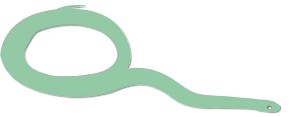 Until recently all Manitoba's snakes were considered to belong to one family, Colubridae. Now, only the Smooth Green Snake is placed in the Colubridae. Our Garter Snakes and the Northern Redbelly Snake now belong to the Natricidae. The Western Hognose Snake is in the Dipsadidae. Current conservation rankings by the Manitoba Conservation Data Centre are included here.
Until recently all Manitoba's snakes were considered to belong to one family, Colubridae. Now, only the Smooth Green Snake is placed in the Colubridae. Our Garter Snakes and the Northern Redbelly Snake now belong to the Natricidae. The Western Hognose Snake is in the Dipsadidae. Current conservation rankings by the Manitoba Conservation Data Centre are included here.
(Click the pictures for more images of each species.)
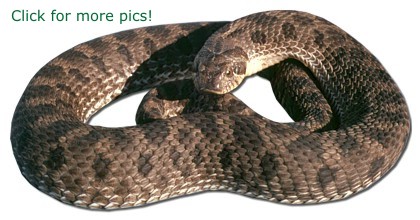 Western Hognose Snake (Heterodon nasicus)
Western Hognose Snake (Heterodon nasicus)
Description: A medium to large, stout-bodied snake, growing up to 150 cm in total length, though most are less than 80 cm. The body is coloured light gray, brown or olive green with dark brown blotches or spots along the sides. The belly is mostly black. The rostrum, or "nose", is upturned like a pig's, giving this species its common name.
Habitat: Grasslands or open woodlands in areas with loose, sandy soils.
Status and Range in Manitoba: The Hognose Snake is considered rare in Manitoba (S1/S2). It is found in the southwest corner of the province.
(This species' range needs to be defined.)
Current Range Map for the Western Hognose Snake.
Overwintering: Below the frost line either burrowing in sandy soil or making use of animal burrows. (See Basic Biology)
Diet: Hognose snakes will eat amphibians, especially toads, as well as other reptiles such as snakes or lizards. They occasionally eat small birds or mammals and will also eat the eggs of other reptiles or ground-nesting birds.
Life Cycle: Mating takes place in May. Clutches of 2 to 25 eggs are laid in July in a nest excavated in loose or sandy soil. Hatchlings emerge in late August or September. (See Basic Biology)
Tips on finding this species: Hognose Snakes, like all our snake species, can often be found along trails or roadways in early to mid morning when they are basking, especially in spring and fall when temperatures are cooler. At other times look for this species by checking under logs, boards or other debris.
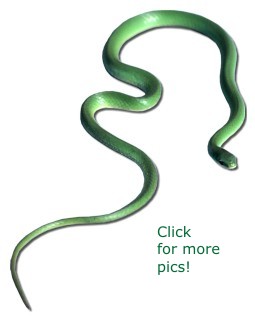 Smooth Green Snake (Opheodrys vernalis)
Smooth Green Snake (Opheodrys vernalis)
Special Note: This species also goes by the name Liochlorophis vernalis. Taxonomists can't seem to make up their minds.
Description: A small snake reaching a maximum of 80 cm, though most are less than 50 cm. They are bright green, with no markings. The belly is white or cream coloured.
Habitat: Occupies a variety of habitats. In Manitoba it is found most often in grasslands in areas with loose, sandy soils, but this may be a function of it being more easily found in such habitats.
Status and Range in Manitoba: The Smooth Green Snake is considered to be common in Manitoba (S3/S4). It is thought to occur across southern Manitoba.
(This species' range needs to be defined.)
Current Range Map for the Smooth Green Snake.
Overwintering: Below the frost line in loose soils. Ant hills may be important overwintering sites for this species. (See Basic Biology)
Diet: Smooth Green Snakes feed mainly on arthropods. Caterpillars, grasshoppers, spiders and beetle larvae are common foods, but they are reported to eat worms and slugs, too.
(Information of the diet of this species in Manitoba needs to be compiled.)
Life Cycle: Mating takes place in May, up to 15 eggs are laid in late July. Hatching occurs about 4 weeks later, in late August. (See Basic Biology)
Tips on finding this species: Smooth Green Snakes can occasionally be found along trails or roadways in early to mid morning when they are basking, especially in spring and fall. This species is more likely to be encountered by looking under logs, boards or other debris.
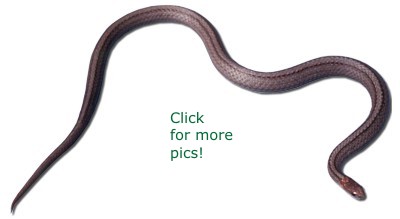 Northern Red-bellied Snake (Storeria occipitomaculata occipitomaculata)
Northern Red-bellied Snake (Storeria occipitomaculata occipitomaculata)
Special Note: The Northern Red-bellied Snake is considered to be a distinct subspecies, but information on the ranges of any other subspecies of Red-bellied Snake are not available, so the range map below is a generic one for S. occipitomaculata.)
Description: A small snake reaching a maximum of 40 cm, but most are less than 30 cm. They can be varying shades of gray or brown, even rusty brown in colour, plain or with darker striping running the length of the body. The belly is red, hence the common name. (Northern Redbelly Snake was formerly the common name of this snake.)
Habitat: Occupies a variety of habitats, perhaps most common in moist woodlands or near wetlands.
Status and Range in Manitoba: The Red-bellied Snake is common in Manitoba (S3/S4). It is thought to occur across the southern part of the province.
(This species' range and habitat preferences needs to be better defined.)
Current Range Map for the Northern Red-bellied Snake.
Overwintering: Below the frost line in loose soils. Ant hills may be important overwintering sites for this species. (See Basic Biology)
Diet: The diet of Red-bellied Snakes is not well known, but they are known to eat worms, slugs and beetle larvae.
(Information of the diet of this species in Manitoba needs to be compiled.)
Life Cycle: Mating probably takes place in May. Females give birth to live young, usually 10-12 in a litter, in August or September. (See Basic Biology)
Tips on finding this species: Red-bellied Snakes can occasionally be found along trails or roadways in early to mid morning when they are basking. This species is may be encountered by looking under logs, boards or other debris.
Plains Garter Snake (Thamnophis radix)
Description: A medium sized snake growing to a maximum of 110 cm, most are less than 70 cm. Body colour can be tan to black with yellow stripes running the length of the body. Darker spots and blotches occur in between the yellow stripes. The dorsal stripe is usually more amber than the lateral stripes and there are tooth-like black markings along the jaw. The lateral yellow stripe runs through scale rows 3 and 4, counting up from the ventral scutes, in this species, which is the best means to distinguish this species from the Red-sided Garter Snake.
Habitat: Primarily grasslands or open woodlands usually near wetlands.
Status and Range in Manitoba: The Plains Garter Snake is common in Manitoba (S4). It is found in the southwestern part of the province to the edges of the aspen parkland and boreal forest.
Current Range Map for the Plains Garter Snake.
Overwintering: Below the frost line. Plains Garter Snakes make use of abandoned small mammal burrows, especially ground squirrel burrows, but may also hibernate around building basements. (See Basic Biology)
Diet: Frogs, toads, worms, tadpoles and small fish are the main diet. On occasion they may eat baby birds, young mice or voles or even dead adult mice, but they are unable to subdue healthy adult small mammals.
Life Cycle: Mating takes place in late April or early May shortly after emergence from the winter dens. Males do not remain near the den entrances for extended periods as occurs in the Red-Sided Garter Snake. Females give birth to live young, up to 60 in a litter, in late August or September. (See Basic Biology)
Tips on finding this species: Plains Garter Snakes can be found basking along trails or roadways in early to mid morning, especially in spring and fall when mornings are cool. They are most often found along the edge of wetlands.
Eastern and Red-sided Garter Snakes (Thamnophis sirtalis)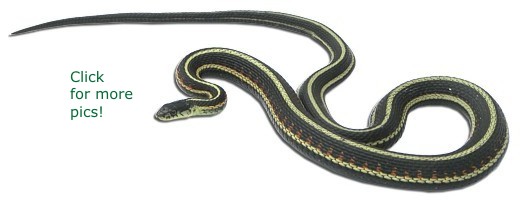
Special Note: Two subspecies of Thamnophis sirtalis occur in Manitoba, the Red-Sided Garter Snake (T. s. parietalis) and the Eastern Garter Snake (T.s. sirtalis). The Red-sided is the more common and widespread of the two with the Eastern Garter Snake restricted to the southeast corner of the province. Most aspects below apply to both subspecies.
Description: A medium sized snake reaching a maximum of 140 cm total length, but most are less than 90 cm. Body colour in Eastern Garter Snakes is grey to olive brown with prominent yellow stripes running the length of the body, one on the center of the back and one down each side. The top of the head will be light brown or olive coloured. There are few spots or blotches along the sides. The yellow lateral line runs through scale rows 2 and 3, up from the ventral scutes (belly scales), but may extend right down to the the ventral scutes.
The Red-sided Garter Snake has a darker body, often almost black, and the top of the head is dark brown or black. There are prominent red blotches between the lateral yellow stripe and the dorsal stripe. The lateral yellow line in more restricted to scale rows 2 and 3, there will be dark body colour between the line and the ventral scutes.
Habitat: Moist woodlands and edges of wetlands.
Status and Range in Manitoba: The Eastern Garter Snake is uncommon in southeastern Manitoba (S3/S4), but the status of this subspecies in not well studied. The Red-sided Garter Snake is common across the southern third of the province. (S4).
(The ranges and degree of overlap of the two subspecies needs to be defined.)
Current Range Map for the Red-sided and Eastern Garter Snakes.
Overwintering: Below the frost line in caves, burrows or holes of various sorts. Red-sided Garter Snakes are renowned for the huge numbers which share underground caves as winter dens in Manitoba's Interlake region. In other parts of the province both Red-sided and Eastern Garter Snakes den in smaller concentrations, but in similar circumstances. (See Basic Biology)
Diet: Frogs, toads, worms, tadpoles and small fish are the main diet. On occasion they may eat baby birds, young mice or voles or even dead adult mice, but they are unable to subdue healthy adult small mammals.
(Information on the diet of this species in Manitoba needs to be compiled.)
Life Cycle: Mating takes place in mid-May. Females give birth to live young, up to 100 in a litter, but nearer 30 on average, in late August or September. (See Basic Biology)
Tips on finding this species: Both Garter Snakes can be found basking along trails or roadways in early to mid morning, especially in spring and fall when mornings are cool. They are most often found along the edge of wetlands.